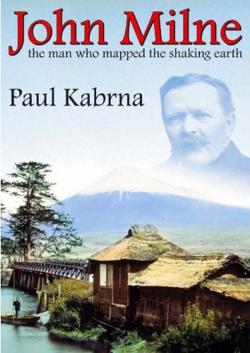John Milne: the man who mapped the shaking earth

Craven and Pendle Geological Society, 2007, 120 pages, paperback £6.50, (Special offer price to Japan Society members, just £5.00 including p & p. E-mail paul_kabrna@msn.com), ISBN 978-0-9555289-0-3
Review by Paul Wignall
The name of John Milne (1850-1913) is today remembered by only a few, and yet he was one of the pioneering giants of late 19th and early 20th century geology and geophysics, who conducted much of his research in Japan. He was dubbed the “father of seismology” shortly after his death and was widely regarded in his lifetime for his work on both volcanoes and earthquakes. Biographies of Milne have not been in print for many years and this new book fills this important gap.
John Milne made his name and reputation in Japan where he is better remembered than in his home country. He was appointed as Professor of Geology and Mining at the newly formed Imperial College of Engineering in Tokyo in 1875 when still only 25, whereupon he began an epic overland journey described in fascinating detail by Kabrna. Once in Japan he was ideally placed to initiate study of such geological phenomena as volcanoes and earthquakes and it was his development of an effective instrument for seismographs that allowed him to make substantial contributions to our understanding of earthquakes. Not least of these was the realization that major earthquakes are not related to volcanic activity. Using his seismographs, which he continued to develop and improve throughout his life, he measured thousands of Japanese earthquakes, and on his return to England and retirement in the Isle of Wight, he carried on this work. He was one of the first to realize that large earthquakes can be measured anywhere in the world. In his later life he was clearly something of a scientific celebrity and his visitors to the Isle of Wight included Queen Victoria and Captain Robert Scott. He has not been entirely forgotten today, he has a pub named after him in his home town of Rochdale, although not many locals are likely to know of his significance.
Kabrna’s book is clearly written, in an accessible style, and provides an effective blend of geology and travelogue. Milne was as well travelled as any modern geologist and even before his appointment in Japan he had participated in expeditions in Newfoundland and the Middle East (Sinai) before undertaking his audacious crossing of Europe and Asia (including crossing Mongolia in winter!). The prolific illustrations, most in colour, add further to the value of this fascinating book.

